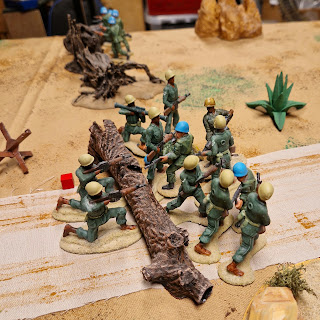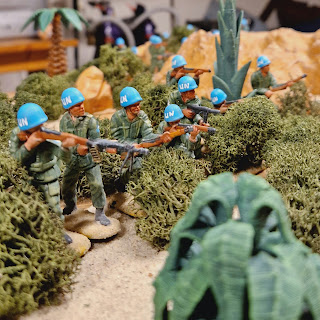Last year (and a couple of times this year as well), I've played several different rules for wargaming I've found online for free which could be used with ordinary toy soldiers and army men. The complete series of reviews can be found on this blog. I played the same setup and scenario each time, which made it easier to see the different rules pros and cons. All the different rules had different advantages and some disadvantages. I wanted to see if it was possible to take most of the elements I consider as 'the best' from the different rules and collect them into one ruleset, and see if it was possible to get it all on one page as well since I'm a fan of one page rules. It became clear with so many great rules; there was not place enough on the paper for including all their best elements together on only one page.
Don't get me wrong; I really enjoyed playing all these different rules found online for free (and had a good time doing it as well), and I'm definitely going to play them over again for different scenarios and periods. At the same time I wanted to see if it was possible to develop my own 'home brewed' house rules based on my experience playing these games made by others. Therefore my rules are heavily influenced by great rules such as FUBAR, 1 BC Toy Soldier rules, Fighting Plastic, OMOG, Close Wars, Wargame in a bag and Plastic Command by Craig Cartmel, Pete Kautz, Corey Butler, Thor Sheil, Donald Featherstone, Nick Grant and J.P. Medved respectively. Thanks for your inspiration! The result of these inspirational games was my own draft for home brewed, onepage rules for army men and toy soldiers.
Developing these home brewed rules was a process so long, so to describe it all in one blogpost would have made it far too long to read in one piece. Instead I've made it into a series of 4 blogposts with a short description and a Battle Report in each which will follow here shortly. It would be tempting to do like George Lucas and start with Episode 4 and the most interesting part right away, but as these rules are playable in all stages I'll show the different stages of the development of them. And IF following Lucas' example; the prequels would not be so interesting...
From my own service abroad I remember we got a single page card with the Rules of Engagement for the mission/conflict. Since my own homebrewed rules for miniature battles also are just a single page, I decided to simply name these Rules of Engagement for Wargaming with Miniatures.
The test
The scenario
- Forces:
- Katangese:
- 2 rifle-squads each of 10 soldiers, a LMG and and a bazooka/flame thrower. Each squad can operate as 2 fireteams independently.
- 1 HMG-detachment of 3 soldiers
- 1 sniper
- HQ-section with platoon-leader and 2 medics
- After turn 12: QRF consisting of 1 truck with a HMG and a section of 10 'veterans' with a LMG and a bazooka arrives from the next village. Only if Lumbaya is still held by Katangese forces.
- UN:
- 1 Platoon of 3 rifle-squads each of 8 soldiers and a LMG. The squads can operate independently.
- 1 Light mortar-detachment of 2 soldiers and an observer
- 1 bazooka-detachment of 3 soldiers
- HQ-section with platoon-leader
- 1 Jeep with HMG and 2 soldiers.
- Katangese: To hold the strongpoint of Lumbaya. Can request QRF-support as mentioned in the force-section from turn 12 if still holding whole or part of the strongpoint.
- UN: To take and hold the strongpoint of Lumbya, preferably within 12 turns, and take control on as many Katangese gendarms located there as possible.
AAR
The Katangese forces managed to successfully pin down several units in the UN advancement for several turns with suppressive fire...
..which really slowed the UN offensive down...When slowly approaching the village, there came to fierce fire-fighting in the outskirts...
And the UN forces was about to make a breakthrough, but by turn 12 the Katangese QRF entered the village, just in time to change the tide of battle.
The UN forces decided to make another push for it, as they were close and about to break through the Katangese defense-lines. The UN Bazooka-team managed to strike a direct hit and took out the Katangese HMG and pickup. Would they make it after all?
In these rules the Katangese QRF are played as an 'elite unit', and their appearance made the UN offensive come to a definite halt.
The UN forces closest to the village met the Katangese QRF first, and were charged into a hand to hand combat, in which they had no chance with this elite unit.
The other UN units got pinned in their positions outside the village...
...which also made it difficult to retreat without leaving any brothers in arms behind...
The UN support-weapons were eventually used to cover the retreat, while the UN troops in the battlefield were striving to get back to their own lines...
...due to enemy fire they were struggling to withdraw from the battle, and only a few of them managed at the end.
Pros
- Being 'own' rules based upon the best of a lots of other rules, so sure there should only be pros in this section, or...? -Well, being own rules makes you remember them easier, as you have used a lot of time tweaking about them, so you don't use so much time for reference check in the rules while playing.
Cons
- I wouldn't exaggerate and claim that these were fast playing rules...
On the contrary. But perhaps that is a pro for some? - I feel it was low casualty rates from shooting, and perhaps that's why the game took so long? On the other side this makes it easier to slow down, suppress and pin units for several turns, which again are as in real combat; slowing down, halt and interrupt enemy actions, forcing the other side to abort, step down or retreat with minimal own losses. Regarding armour-savings; I remember from my own service we always asked 'if we had to wear helmets' during different exercises as we preferred to use our berets or field caps instead. Now it's clear why wearing helmets have it's benefits, even in a wargame.
























































.jpg)





